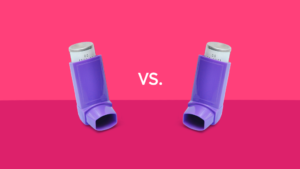GMI vs. A1C: Comparing Glucose Management Indicator and A1C in Type 1 Diabetes
HOME | DIABETES EDUCATION | (GLUCOSE MANAGEMENT INDICATOR) GMI VS A1C: TYPE 1 DIABETES
Navigating Type 1 Diabetes management requires understanding the differences between GMI and A1C. Both metrics are crucial for optimizing diabetes management. Knowing when and how to use each can impact overall health.
How can you effectively leverage both GMI and A1C in your diabetes management plan for the best outcomes?
Key Takeaways; GMI vs A1C
- GMI measures average glucose levels using CGM data and may be more reflective of true average glucose compared to A1C.
- Factors such as anemia, genetic conditions, and chronic kidney disease can affect A1C levels, while GMI is less affected by lab interference.
- GMI offers a comprehensive view of glucose levels and can be used to adjust target goals for diabetes management.
- Incorporating TIR (Time in Range) into diabetes management, along with GMI, allows for a more holistic approach and a better understanding of glucose fluctuations.
Understanding GMI and A1C in Diabetes Management
Understanding the differences between GMI and A1C is crucial for effectively managing Type 1 Diabetes and tailoring personalized treatment plans. A1C measures average blood glucose levels over 2-3 months based on red blood cell turnover, while GMI can be checked more frequently using CGM data.
Factors like anemia and genetic conditions can affect A1C, and chronic kidney disease can result in falsely low A1C levels. A recent study found that only 11% of people showed less than a 0.1 percentage point difference between their A1C and GMI, while 50% had differences of 0.5 percentage points or less.
GMI may be more reflective of true average glucose and has been relied on more during COVID-19 when lab tests are challenging to obtain. TIR, which measures how often blood sugar levels stay within the target range, can be used in conjunction with GMI to assess glucose management.
GMI: A More Comprehensive Measure for Diabetics?
GMI offers a more dynamic and reflective measure of average glucose levels, providing a valuable alternative to A1C testing in diabetes management. It gives a comprehensive view of glucose levels, allowing for a more personalized and accurate diabetes management plan.
Factors such as anemia and genetic conditions can affect A1C, while GMI may reflect true average glucose levels more. A recent study found that only 11% of people showed less than a 0.1 percentage point difference between their A1C and GMI, indicating that they may not always align perfectly.
Additionally, GMI provides insight into the next A1C result and can be used to adjust target goals, minimizing the risk of hypoglycemia or hyperglycemia.
Interpreting A1C tests for Type 1 Diabetes
Interpreting A1C tests for Type 1 Diabetes requires understanding how this measure reflects average blood glucose levels over 2-3 months. Factors to consider include glucose variability, TIR, and the use of continuous glucose monitoring (CGM) data. Below is a table comparing A1C and GMI:
| Measure | A1C | GMI |
|---|---|---|
| Definition | glucose level | CGM-based average glucose |
| Reflection | 2-3 months | 3 months |
| Accessibility | Lab test | Available in CGM reports |
| Accuracy | Limited by fluctuations | Reflects true average glucose |
| Clinical Use | Traditional | Gaining prominence during COVID-19 |
Understanding these measures is crucial for effective diabetes management, and consulting a diabetes care and education specialist can help interpret and apply this data effectively.
GMI Vs. A1C: Key Differences
When comparing GMI and A1C for managing Type 1 Diabetes, it is important to consider the distinct differences in their reflection of glucose levels and their clinical implications. Understanding these differences can help individuals better manage their diabetes with the guidance of a diabetes care and education specialist. Key differences to note include:
- A1C reflects average blood glucose levels over 2 to 3 months, while GMI can be checked more frequently using CGM data.
- Factors such as anemia and genetic conditions can affect A1C, while reduced kidney function may result in falsely low A1C levels.
- GMI may overestimate A1C in individuals with specific A1C levels, and the two measurements may not always be a perfect match.
Using CGM can help guide diabetes management in real time with minute-to-minute glucose values and trend arrows as well as retrospectively with an analysis of glucose metrics and patterns. The core glucose metrics to help clinicians evaluate the effectiveness of the current diabetes management plan include average glucose, GMI, time in range (time in target range 70–180 mg/dL), time in hypoglycemia (<70 and <54 mg/dL), time in hyperglycemia (>180 and >250 mg/dL), and a measure of glucose variability (coefficient of variation, which is SD divided by mean glucose). While average glucose, GMI, time in hyperglycemia, and time in target range all give a similar perspective on overall glucose management to the A1C (all being mostly influenced by the degree of hyperglycemia present), the additional metrics of time in hypoglycemia and glycemic variability add critical information beyond the A1C value to assess whether there are added safety concerns that need to be addressed in the diabetes management plan.
Target Time in Ranges for GMI and A1C
The target time in range (TIR) for GMI generally falls around 70-180 mg/dL for approximately 70% of the time. The goal for most adults with diabetes is to maintain a GMI of less than 7%. The normal range for GMI is below 5.7%, while the diabetes range is 6.5% and higher.
Focusing on time in range can significantly improve both GMI and A1C outcomes. Continuous glucose monitoring (CGM) data, such as that available through Dexcom, can be instrumental in understanding and optimizing TIR and average glucose levels, contributing to more effective diabetes management.
Working with a diabetes care and education specialist can provide valuable guidance in this process.
Incorporating TIR Into Diabetes Management
Incorporating Time in Range (TIR) into diabetes management can significantly enhance the understanding of glucose fluctuations and aid in optimizing both GMI and A1C outcomes. Understanding TIR and its impact on glucose management is crucial.
TIR can be improved through various strategies and technologies, such as frequent monitoring with continuous glucose monitoring (CGM) systems like Dexcom. It’s essential to work with a diabetes care and education specialist to interpret CGM data and set appropriate TIR targets.
By incorporating TIR into your diabetes management, you can gain insights into average glucose levels and glucose variability, allowing for better adjustments in your treatment plan to minimize the risk of hypoglycemia or hyperglycemia.
The Role of GMI (Glucose Management Indicator) in Personalized Care
GMI is a real-time tool for assessing glucose control in individuals with Type 1 Diabetes, based on continuous glucose monitoring (CGM) data. It allows for more frequent adjustments compared to traditional A1C measurements, offering a comprehensive understanding of glucose levels.
Dexcom incorporates GMI into its reports, empowering individuals and healthcare professionals to make informed decisions for personalized care. GMI reflects real-time glucose fluctuations and is less affected by lab interference compared to the A1C method.
Integrating GMI with Time in Range (TIR) allows for a more holistic approach to diabetes management and helps individuals set and achieve personalized A1C targets. Diabetes care and education specialists play a crucial role in guiding individuals to interpret and utilize GMI data effectively for improved diabetes management.
Utilizing GMI and A1C Together for People with Diabetes
GMI and A1C measurements provide a comprehensive understanding of blood sugar control for individuals with diabetes. Understanding glucose variability is crucial, as GMI reflects glucose management through CGM data, offering insights into continuous glucose levels and variability.
A1C complements GMI data by providing an average glucose value over time, allowing for personalized management plans. Assessing both GMI and A1C, along with focusing on TIR, can help individuals optimize their blood sugar control and make informed decisions about their diabetes management.
Practical Applications of GMI and A1C Levels
The practical application of GMI and A1C in managing Type 1 diabetes involves understanding their strengths and limitations to optimize blood sugar control. Factors such as glucose variability, CGM data, and average glucose levels are crucial in constructing an effective diabetes management plan. Below, the table compares GMI and A1C, highlighting their practical applications.
| Aspect | GMI |
|---|---|
| Testing frequency | CGM data-based frequent testing |
| Influence of factors | Less affected by anemia and CKD |
| Concordance with A1C | May overestimate A1C in certain levels |
| Clinical relevance | Real-time reflection of glucose levels |
| Importance for TIR | Crucial for assessing glucose control |
Understanding these aspects can empower you to work with your diabetes care and education specialist to make informed decisions about your diabetes management.
GMI and A1C: Monitoring Tools Comparison
GMI and A1C differ in their capabilities and implications for glucose control in Type 1 diabetes management. Here’s what you need to consider:
A1C measures average blood glucose levels over two to three months, while GMI can be checked more frequently based on CGM data, providing a more comprehensive view of glucose fluctuations.
Factors such as anemia, genetic conditions affecting hemoglobin, and chronic kidney disease can affect A1C, leading to inaccuracies, whereas GMI may be more reflective of true average glucose levels.
Studies have shown variability in the correlation between GMI and A1C, with some individuals exhibiting significant differences, emphasizing the need for personalized diabetes management strategies.
GMI and A1C in Type 1 Diabetes Care
Moving into the discussion of GMI and A1C in Type 1 Diabetes Care, it’s important to understand the differences in their capabilities and implications. GMI, based on continuous glucose monitoring (CGM) data, allows for more frequent checks and provides an average glucose value equivalent to a three-month blood glucose concentration.
On the other hand, A1C measures average blood glucose levels over 2-3 months. Factors such as anemia and chronic kidney disease can affect A1C levels, while GMI may provide a more reflective average glucose value without lab interference.
Understanding these distinctions is crucial for informed decision-making in collaboration with a diabetes care and education specialist. Focusing on Time in Range (TIR) can enhance both GMI and A1C outcomes, contributing to more effective diabetes management.
GMI and A1C: Balancing Glucose Management
Balancing glucose management requires a comprehensive understanding of the strengths and limitations of both GMI and A1C measurements in Type 1 Diabetes care. When managing your glucose levels, consider the following:
- CGM Data: Utilize continuous glucose monitoring (CGM) data from devices like Dexcom to track real-time glucose levels and make immediate adjustments to your management plan.
- Time In Range: Focus on increasing your time in range, as this metric has a direct impact on both your GMI and A1C levels, providing a more accurate representation of your average glucose.
- Consultation: Regularly consult with a diabetes care and education specialist to interpret GMI and A1C results and tailor your management strategies accordingly.
Understanding and balancing these factors will help in achieving better glucose management and overall well-being.
Frequently Asked Questions
What Is the Ideal GMI for Type 1 Diabetes?
The ideal GMI for Type 1 Diabetes is typically less than 7%. GMI complements A1C in diabetes management, providing insights into glucose variability. Maintaining a GMI below 7% supports effective diabetes control.
Is A1C or GMI More Accurate?
GMI and A1C are both crucial in managing Type 1 Diabetes, but neither is definitively more accurate. A comprehensive approach that considers both GMI and A1C can provide a more nuanced understanding of blood sugar control.
What Is the Correlation Between GMI and Hba1c?
The correlation between GMI and HbA1c is significant in understanding glucose management in diabetes. GMI and HbA1c may not perfectly align, but both provide insights into glucose management and complications.
What Is the Best CGM for Type 1 Diabetes?
The best CGM for managing type 1 diabetes is one that provides accurate real-time data on blood sugar levels, offers user-friendly features for continuous monitoring, and integrates seamlessly with diabetes management tools.



